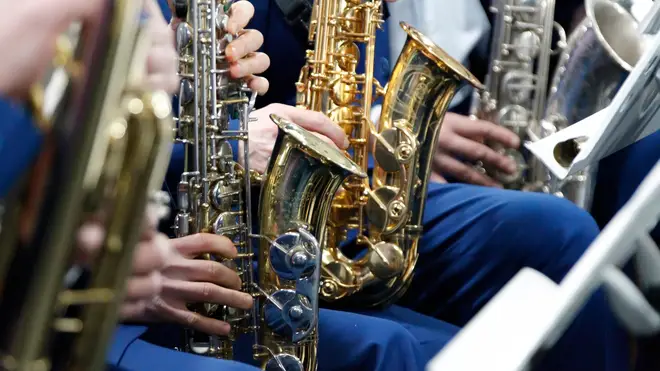On Air Now
Calm Classics with Myleene Klass 10pm - 1am
23 December 2021, 17:15 | Updated: 21 December 2023, 12:42

Did you know Debussy wrote a solo orchestral piece for saxophone?
One of the youngest instruments of the classical world is the saxophone.
Although often heavily associated with jazz, the saxophone was invented in 1846, way before the development of the early 20th century genre.
Made in Belgium by Adolphe Sax, the four most common saxophones are soprano, alto, tenor and baritone. However, there are actually 14 different types of saxophones, ranging from the extremely high (Sopranissimo) to the extremely low (Subcontrabass).
Here are some of the classical pieces we think every classical sax novice should listen to.
Read more: This is the largest playable saxophone in the world, and it sounds brilliantly monstrous
Jacques Ibert started writing his concerto for alto saxophone in 1935, just one year after his successful concerto for flute.
The Concertino da Camera is scored for alto saxophone and a small orchestra, and split into just two movements – Allegro con moto and Animato molto.
It was written for the German-American virtuoso saxophonist Sigurd Rascher, and because of the technical skills needed, it was thought to be unplayable by most people when it was first written.

Concertino da Camera by Jacques Ibert - Arno Bornkamp
Paul Creston’s Sonata for alto saxophone and piano is a standard and favourite across the saxophone repertoire.
Written in 1939, the work is made up of three movements, With vigor, With vigor, and With gaiety, and across each, Creston utilises the full range of the saxophone.
Creston was born Giuseppe Guttoveggio, however after living in America in the early 20th century, the Italian-American composer decided to legally change his professional surname early on in his career.

Saxophone Sonata, Op. 19: I. With vigor
Translating literally as ‘Provence paintings’, each of the five movements in Paule Maurice’s Tableaux de Provence metaphorically paints a picture of scenes happening in the French region.
The programmatic suite was composed between 1948 and 1955 for alto saxophone and orchestra, though it is often performed with just saxophone and piano. The work was dedicated to the French saxophone virtuoso, Marcel Mule, and Provence was chosen as inspiration for the piece as it is where both the Mule family, and as well as Maurice’s, went on holiday.

Paule Maurice - Tableaux de Provence
The Caprice en forme de valse by Paul Bonneau is often referred to as the most virtuosic piece for solo saxophone. It has typically French characteristics, with difficult chromatic runs making up a vast majority of the score.
It is incredibly technically demanding, and can be performed on any saxophone of the performer’s choosing. The recording below is played on an alto saxophone.

Paul Bonneau - Caprice en forme de valse
Our only work specifically for soprano saxophone on this list is the Fantasia for Soprano Saxophone by Brazilian composer, Heitor Villa-Lobos.
Scored for saxophone and orchestra, Villa-Lobos chose the name Fantasia for his piece as he said it freed him from traditional boundaries, such as those associated with other concertante works.
The music incorporates nationalistic musical elements of Brazil along with melodic, lullaby-like themes, to make a truly contrasting and interesting three-movement work.

Villa-Lobos Fantasia; Katherine Weintraub, Soprano Saxophone
One of the most virtuosic pieces on our list is the Fuzzy Bird Sonata, by self-taught Japanese composer, Takashi Yoshimatsu.
Written in 1991, the work for saxophone and piano follows a standard three-movement sonata format however, his styles cross over multiple genre-barriers. His music references everything from neo-Romantic, jazz, free, rock, and traditional Japanese music. The Fuzzy Bird in the title references a bird flying between all these different genres.
The work was followed three years later by another virtuosic piece for saxophone, the Cyber Bird Concerto.

Nobuya Sugawa - Fuzzy Bird Sonata - I. Run, Bird.
This work for saxophone and orchestra is based on the 2002 film, Catch me if you can, starring Leonardo DiCaprio and Tom Hanks and directed by Steven Spielberg.
Film composer John Williams wrote the music for the film, which is set in the 1960s. Due to the progressive nature of jazz during this decade, Williams thought a saxophone would be best to express this musically, and so this suite of three movements starring the instrument was born.

John Williams conducts Escapades for Alto Saxophone and Orchestra (Catch Me if you Can)
Spanish Saxophonist, Pedro Iturralde’s showpiece, Pequeña Czarda is a favourite in saxophone repertoire. Its fast passages, virtuosic cadenza, and overall accelerando and build throughout the piece makes it very fun to play, and puts the saxophone right in centre stage.
Iturralde wrote Pequeña Czarda when he was just 20 years old (in 1949) and has arrangements for saxophone and piano, saxophone and orchestra, and saxophone and wind band.

Jess Gillam plays Iturralde’s ‘Pequeña Czarda’ with pianist Zeynep Ozsuca
Written in 1902 by Belgian composer André Waignein, Deux Mouvements was commissioned by the director of the Royal Conservatoire in Bruxelles, a close friend of Waignein, as he wanted a piece which could be played by the conservatoire’s saxophone class.
Waignein’s father was a saxophonist, which would explain his natural talent writing so lyrically for the instrument.

Deux Mouvements - André Waignein - Simon Diricq and Flavien Casaccio
Written between 1901 and 1911, Claude Debussy’s Rhapsodie for saxophone and orchestra was originally more orchestra than saxophone, with the saxophone only having a few solo lines throughout the score.
However, many arrangers have take Debussy’s orchestral score and re-written the melodies for saxophone in virtuosic altissimo passages, such as the arrangement below by Vincent David.

Andorra Saxfest 2019 - Claude Delangle - Rhapsodie with orchestra by C .Debussy